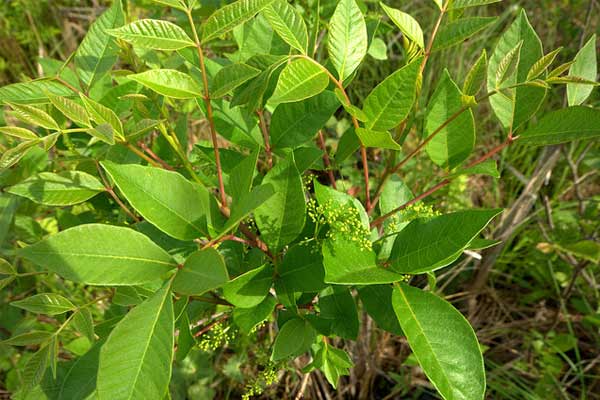Poison Sumac - Poisonous Shrub
Poison Sumac is a woody shrub that can grow to the size of a small tree and contains a toxic resin that is very irritating to humans. It is common in Canada and the Eastern United States, including the Adirondacks, growing exclusively in regions with extremely moist soil.
What Does It Look Like?

Because it starts out small and looks similar to other harmless plants, it is important to note the red stems and other distinguishing factors of the Poison Sumac shrub to help you avoid it. Please note: the non-poisonous Sumac yields clusters of red berries and is extremely common throughout the Adirondacks (and completely harmless). Poison Sumac contrasts with other sumacs by having shorter leaves that aren't as elongated and are smooth around the edges.
Key facts for identification:
- Grows up to 20 feet tall
- Has red stems
- Leaves have smooth edges and are wide rather than narrow
- Leaves grow opposite one another in two directions along the stem
- Blooms yellow-green flowers in June and July
- Yields white or gray berries in September
- Grows in swamps and extremely moist or flooded areas
How Is It Harmful?
Poison Sumac is a serious irritant that produces a burning, itchy rash comparable to poison ivy and lasting several days to weeks. All parts of the Poison Sumac plant are toxic, causing irritation to the skin and mucous membranes. It should also be noted that smoke from burning the shrub also causes internal irritation, inflammation and diarrhea.
How To Avoid It?
Recognizing Poison Sumac on sight is the key to avoiding it. Be especially cautious if you are trekking in very moist soil. Do not touch or allow your clothing to come into contact with this plant. The image and identification facts provided here will better equip you to recognize and steer clear of this irritating shrub.
What If I Touched It?
If your skin or clothing has come into contact with a Poison Sumac plant, thoroughly wash the affected area as soon as possible to remove the oil that causes irritation. It is wise to seek medical treatment.
Sources:
https://www.dot.ny.gov/dangerous-plants/poison-sumac
http://www.nlm.nih.gov/medlineplus/ency/article/000027.htm
Photo Credit: Joshua Mayer: Poison Sumac (Toxicodendron vermix) (license)